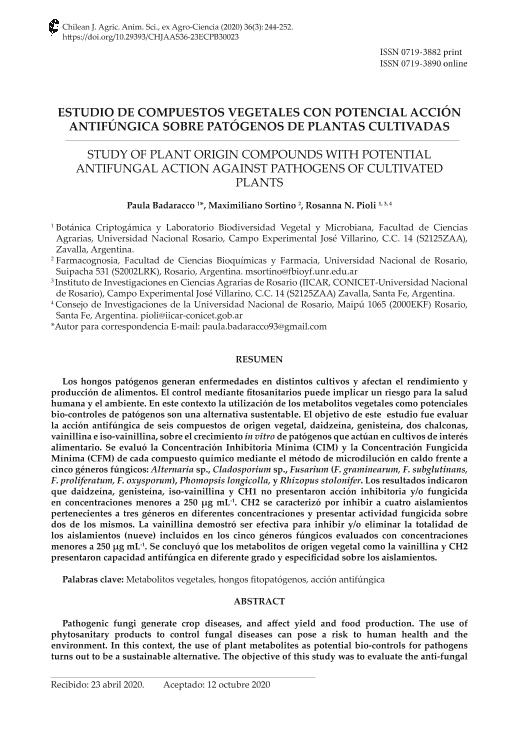Artículo
Los hongos patógenos generan enfermedades en distintos cultivos y afectan el rendimiento y producción de alimentos. El control mediante fitosanitarios puede implicar un riesgo para la salud humana y el ambiente. En este contexto la utilización de los metabolitos vegetales como potenciales bio-controles de patógenos son una alternativa sustentable. El objetivo de este estudio fue evaluar la acción antifúngica de seis compuestos de origen vegetal, daidzeína, genisteína, dos chalconas, vainillina e iso-vainillina, sobre el crecimiento in vitro de patógenos que actúan en cultivos de interés alimentario. Se evaluó la Concentración Inhibitoria Mínima (CIM) y la Concentración Fungicida Mínima (CFM) de cada compuesto químico mediante el método de microdilución en caldo frente a cinco géneros fúngicos: Alternaria sp., Cladosporium sp., Fusarium (F. graminearum, F. subglutinans, F. proliferatum, F. oxysporum), Phomopsis longicolla, y Rhizopus stolonifer. Los resultados indicaron que daidzeína, genisteína, iso-vainillina y CH1 no presentaron acción inhibitoria y/o fungicida en concentraciones menores a 250 µg mL-1. CH2 se caracterizó por inhibir a cuatro aislamientos pertenecientes a tres géneros en diferentes concentraciones y presentar actividad fungicida sobre dos de los mismos. La vainillina demostró ser efectiva para inhibir y/o eliminar la totalidad de los aislamientos (nueve) incluidos en los cinco géneros fúngicos evaluados con concentraciones menores a 250 µg mL-1. Se concluyó que los metabolitos de origen vegetal como la vainillina y CH2 presentaron capacidad antifúngica en diferente grado y especificidad sobre los aislamientos. Pathogenic fungi generate crop diseases, and affect yield and food production. The use of phytosanitary products to control fungal diseases can pose a risk to human health and the environment. In this context, the use of plant metabolites as potential bio-controls for pathogens turns out to be a sustainable alternative. The objective of this study was to evaluate the anti-fungal action of six compounds of plant origin: daidzein, genistein, two chalcones, vanillin and isovanillin, on the in vitro growth of pathogens. The Minimum Inhibitory Concentration (MIC) and the Minimum Fungicidal Concentration (CFM) of each chemical compound were evaluated by the broth micro-dilution method against five fungal genera: Alternaria sp., Cladosporium sp., Fusarium (F. graminearum, F. subglutinans, F. proliferatum, F. oxysporum), Phomopsis longicolla, and Rhizopus stolonifer. The results indicated that daidzein, genistein, iso-vanillin and CH1 did not show an inhibitory and / or fungicidal action at concentrations lower that 250 µg mL-1. CH2 was characterized by inhibiting four isolates belonging to three genera in different concentrations, and presenting fungicidal activity on two of them. Vanillin proved to be effective to inhibit and / or eliminate all of the isolates (nine) included in the five fungal genera evaluated at concentrations below 250 µg mL-1. It is concluded that metabolites of plant origin such as vanillin and CH2 presented antifungal capacity in different degrees and specificity on the isolates.
Estudio de compuestos vegetales con potencial acción antifúngica sobre patógenos de plantas cultivadas
Título:
Study of plant origin compounds with potential antifungal action against pathogens of cultivated plants
Fecha de publicación:
18/12/2020
Editorial:
Universidad de Concepción
Revista:
Chilean Journal of Agricultural Research
ISSN:
0719-3882
e-ISSN:
0719-3890
Idioma:
Español
Tipo de recurso:
Artículo publicado
Clasificación temática:
Resumen
Palabras clave:
METABOLITOS VEGETALES
,
HONGOS FITOPATÓGENOS
,
ACCIÓN ANTIFÚNGICA
Archivos asociados
Licencia
Identificadores
Colecciones
Articulos(CCT - ROSARIO)
Articulos de CTRO.CIENTIFICO TECNOL.CONICET - ROSARIO
Articulos de CTRO.CIENTIFICO TECNOL.CONICET - ROSARIO
Articulos(IICAR)
Articulos de INST. DE INVESTIGACIONES EN CIENCIAS AGRARIAS DE ROSARIO
Articulos de INST. DE INVESTIGACIONES EN CIENCIAS AGRARIAS DE ROSARIO
Citación
Badaracco, Paula; Sortino, Maximiliano Andrés; Pioli, Rosanna Nora; Estudio de compuestos vegetales con potencial acción antifúngica sobre patógenos de plantas cultivadas; Universidad de Concepción; Chilean Journal of Agricultural Research; 36; 3; 18-12-2020; 244-252
Compartir




